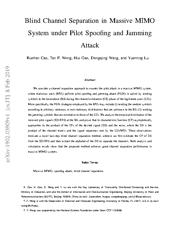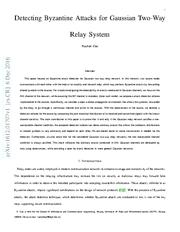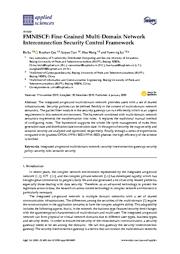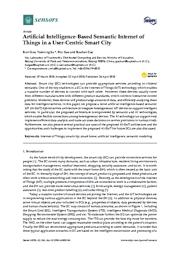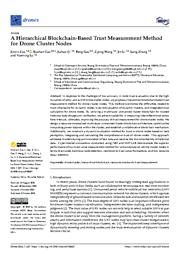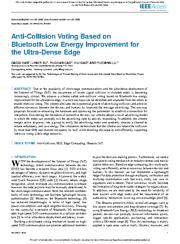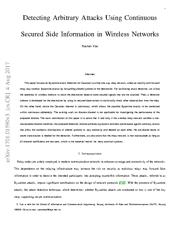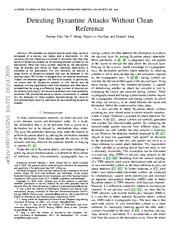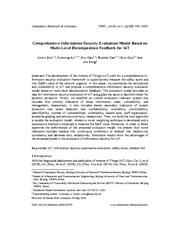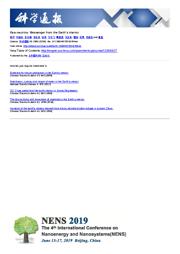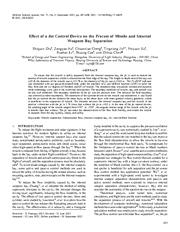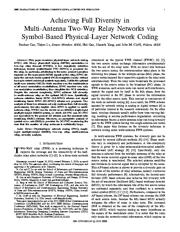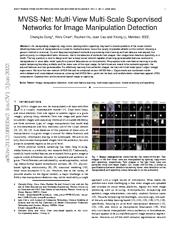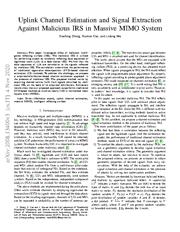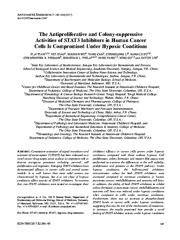A copy of this work was available on the public web and has been preserved in the Wayback Machine. The capture dates from 2020; you can also visit the original URL.
The file type is application/pdf.
Filters
Blind Channel Separation in Massive MIMO System under Pilot Spoofing and Jamming Attack
[article]
2019
arXiv
pre-print
We consider a channel separation approach to counter the pilot attack in a massive MIMO system, where malicious users (MUs) perform pilot spoofing and jamming attack (PSJA) in uplink by sending symbols to the basestation (BS) during the channel estimation (CE) phase of the legitimate users (LUs). More specifically, the PSJA strategies employed by the MUs may include (i) sending the random symbols according to arbitrary stationary or non-stationary distributions that are unknown to the BS; (ii)
arXiv:1902.03909v1
fatcat:jaksv6mbuzhtvaxv36nf5tchuq
more »
... ending the jamming symbols that are correlative to those of the LUs. We analyze the empirical distribution of the received pilot signals (ED-RPS) at the BS, and prove that its characteristic function (CF) asymptotically approaches to the product of the CFs of the desired signal (DS) and the noise, where the DS is the product of the channel matrix and the signal sequences sent by the LUs/MUs. These observations motivate a novel two-step blind channel separation method, wherein we first estimate the CF of DS from the ED-RPS and then extract the alphabet of the DS to separate the channels. Both analysis and simulation results show that the proposed method achieves good channel separation performance in massive MIMO systems.
Detecting Byzantine Attacks for Gaussian Two-Way Relay System
[article]
2016
arXiv
pre-print
This paper focuses on Byzantine attack detection for Gaussian two-way relay network. In this network, two source nodes communicate with each other with the help of an amplify-and-forward relay which may perform Byzantine attacks by forwarding altered symbols to the sources. For simple investigating the detectability of attacks conducted in Gaussian channels, we focus on the MA channel of the network, while assuming the BC channel is noiseless. Upon such model, we propose a attack detection
arXiv:1612.01707v1
fatcat:k7hxbrjusvbqhk23jf7br456uu
more »
... e implemented in the sources. Specifically, we consider a open wireless propagation environment that allows the symbols, forwarded by the relay, to go through a continuous channel and arrive to the sources. With the observations of the source, we develop a detection scheme for the source by comparing the joint empirical distribution of its received and transmitted signals with the known channel statistics. The main contribution of this paper is to prove that if and only if the Gaussian relay network satisfies a non-manipulable channel condition, the proposed detection scheme can detect arbitrary attacks that allows the stochastic distributions of altered symbols to vary arbitrarily and depend on each other. No pre-shared secret or secret transmission is needed for the detection. Furthermore, we also prove that for the considered Gaussian two-way relay networks, the non-manipulable channel condition is always satisfied. This result indicates that arbitrary attacks conducted in MA Gaussian channels are detectable by only using observations, while providing a base for attack detection in more general Gaussian networks.
FMNISCF: Fine-Grained Multi-Domain Network Interconnection Security Control Framework
2020
Applied Sciences
The integrated air-ground multi-domain network provides users with a set of shared infrastructures. Security policies can be defined flexibly in the context of multi-domain network semantics. The packet filter module in the security gateway can run efficiently, which is an urgent requirement in this network environment. The framework combined with multi-domain network semantics implements the transformation into rules. It replaces the traditional manual method of configuring rules. The
doi:10.3390/app10010409
fatcat:wy55k367enefdhyvfuexb4saqi
more »
... supports the whole life cycle management of rules from generation state and distribution state to execution state. In the aspect of security, the map security and semantic security are analyzed and optimized, respectively. Finally, through a series of experiments, compared with iptables/DPDK-IPFW/BSD-IPFW/BSD-pfsense, the high efficiency of the scheme is verified.
Artificial Intelligence-Based Semantic Internet of Things in a User-Centric Smart City
2018
Sensors
Smart city (SC) technologies can provide appropriate services according to citizens' demands. One of the key enablers in a SC is the Internet of Things (IoT) technology, which enables a massive number of devices to connect with each other. However, these devices usually come from different manufacturers with different product standards, which confront interactive control problems. Moreover, these devices will produce large amounts of data, and efficiently analyzing these data for intelligent
doi:10.3390/s18051341
pmid:29701679
pmcid:PMC5982249
fatcat:u6xkuhimrndfzmw5bhrsl54v24
more »
... vices. In this paper, we propose a novel artificial intelligence-based semantic IoT (AI-SIoT) hybrid service architecture to integrate heterogeneous IoT devices to support intelligent services. In particular, the proposed architecture is empowered by semantic and AI technologies, which enable flexible connections among heterogeneous devices. The AI technology can support very implement efficient data analysis and make accurate decisions on service provisions in various kinds. Furthermore, we also present several practical use cases of the proposed AI-SIoT architecture and the opportunities and challenges to implement the proposed AI-SIoT for future SCs are also discussed. massive amount of data collected from various devices/objects in the SC. Moreover, the intelligent services that help users to make smarter decisions are increasingly popular, because the quality of experience (QoE) is increasingly important in SC applications [9] . However, the demand for intelligent services requires an extremely strong data processing capability, which motivates the artificial intelligence (AI) empowered system in the SH [10]. Sensors 2018, 18, x FOR PEER REVIEW 2 of 22 noted that these typical application scenarios in SC are based on the intelligent transmission and processing of a massive amount of data collected from various devices/objects in the SC. Moreover, the intelligent services that help users to make smarter decisions are increasingly popular, because the quality of experience (QoE) is increasingly important in SC applications [9] . However, the demand for intelligent services requires an extremely strong data processing capability, which motivates the artificial intelligence (AI) empowered system in the SH [10].
A Hierarchical Blockchain-Based Trust Measurement Method for Drone Cluster Nodes
2023
Drones
In response to the challenge of low accuracy in node trust evaluation due to the high dynamics of entry and exit of drone cluster nodes, we propose a hierarchical blockchain-based trust measurement method for drone cluster nodes. This method overcomes the difficulties related to trust inheritance for dynamic nodes, trust re-evaluation of dynamic clusters, and integrated trust calculation for drone nodes. By utilizing a multi-layer unmanned cluster blockchain for trusted historical data storage
doi:10.3390/drones7100627
fatcat:ujwjx6raefhrfmqamqlrdopraq
more »
... nd verification, we achieve scalability in measuring intermittent trust across time intervals, ultimately improving the accuracy of trust measurement for drone cluster nodes. We design a resource-constrained multi-layer unmanned cluster blockchain architecture, optimize the computing power balance within the cluster, and establish a collaborative blockchain mechanism. Additionally, we construct a dynamic evaluation method for trust in drone nodes based on task perception, integrating and calculating the comprehensive trust of drone nodes. This approach addresses trusted sharing and circulation of task data and resolves the non-inheritability of historical data. Experimental simulations conducted using NS3 and MATLAB demonstrate the superior performance of our trust value measurement method for unmanned aerial vehicle cluster nodes in terms of accurate malicious node detection, resilience to trust value fluctuations, and low resource delay retention.
Anti-Collision Voting Based on Bluetooth Low Energy Improvement for the Ultra-Dense Edge
2021
IEEE Access
Due to the popularity of short-range communications and the ultra-dense deployment of the Internet of Things (IoT), the occurrence of severe signal collision in crowded nodes is becoming increasingly critical. We propose a scheme called anti-collision voting based on Bluetooth low energy improvement for the ultra-dense edge, in which one topic can be identified and separated from the others to enable intensive voting. The scheme alleviates the exponential growth of advertising collisions and
doi:10.1109/access.2021.3079120
fatcat:buxcpy3srnbnjijhvv7f4t6ohi
more »
... ieves efficient consensus between the devices and humans by localized the message advertising. The previous proposals focused on enhancing the hardware and optimizing the parameters to establish a connection for interaction. Considering the limitation of connective devices, our scheme adopts a novel advertising model in which the nodes can promptly exit the advertising state by actively responding. In addition, the scheme merges active responses into a group to notify the advertising nodes and randomly chooses a channel to reduce redundancy and save energy. The simulations demonstrate that the scheme can reduce the collisions by more than 90% and channel occupancy by half, while doubling the capacity and efficiently supporting intensive voting within edge networks.
Detecting Arbitrary Attacks Using Continuous Secured Side Information in Wireless Networks
[article]
2017
arXiv
pre-print
This paper focuses on Byzantine attack detection for Gaussian two-hop one-way relay network, where an amplify-and-forward relay may conduct Byzantine attacks by forwarding altered symbols to the destination. For facilitating attack detection, we utilize the openness of wireless medium to make the destination observe some secured signals that are not attacked. Then, a detection scheme is developed for the destination by using its secured observations to statistically check other observations
arXiv:1701.01590v3
fatcat:xxxyf4vrjbfa7dj4qomgr7xxle
more »
... the relay. On the other hand, notice the Gaussian channel is continuous, which allows the possible Byzantine attacks to be conducted within continuous alphabet(s). The existing work on discrete channel is not applicable for investigating the performance of the proposed scheme. The main contribution of this paper is to prove that if and only if the wireless relay network satisfies a non-manipulable channel condition, the proposed detection scheme achieves asymptotic errorless performance against arbitrary attacks that allow the stochastic distributions of altered symbols to vary arbitrarily and depend on each other. No pre-shared secret or secret transmission is needed for the detection. Furthermore, we also prove that the relay network is non-manipulable as long as all channel coefficients are non-zero, which is not essential restrict for many practical systems.
Detecting Byzantine Attacks Without Clean Reference
2016
IEEE Transactions on Information Forensics and Security
We consider an amplify-and-forward relay network composed of a source, two relays, and a destination. In this network, the two relays are untrusted in the sense that they may perform Byzantine attacks by forwarding altered symbols to the destination. Note that every symbol received by the destination may be altered, and hence no clean reference observation is available to the destination. For this network, we identify a large family of Byzantine attacks that can be detected in the physical
doi:10.1109/tifs.2016.2596140
fatcat:wmeowfwrzfes5d6h7qrsiybfva
more »
... . We further investigate how the channel conditions impact the detection against this family of attacks. In particular, we prove that all Byzantine attacks in this family can be detected with asymptotically small miss detection and false alarm probabilities by using a sufficiently large number of channel observations if and only if the network satisfies a non-manipulability condition. No pre-shared secret or secret transmission is needed for the detection of these attacks, demonstrating the value of this physical-layer security technique for counteracting Byzantine attacks.
Comprehensive Information Security Evaluation Model Based on Multi-Level Decomposition Feedback for IoT
2020
Computers Materials & Continua
The development of the Internet of Things (IoT) calls for a comprehensive information security evaluation framework to quantitatively measure the safety score and risk (S&R) value of the network urgently. In this paper, we summarize the architecture and vulnerability in IoT and propose a comprehensive information security evaluation model based on multi-level decomposition feedback. The evaluation model provides an idea for information security evaluation of IoT and guides the security decision
doi:10.32604/cmc.2020.010793
fatcat:4uhdauwldjbiveknpm65u74wky
more »
... maker for dynamic protection. Firstly, we establish an overall evaluation indicator system that includes four primary indicators of threat information, asset, vulnerability, and management, respectively. It also includes eleven secondary indicators of system protection rate, attack detection rate, confidentiality, availability, controllability, identifiability, number of vulnerabilities, vulnerability hazard level, staff organization, enterprise grading and service continuity, respectively. Then, we build the core algorithm to enable the evaluation model, wherein a novel weighting technique is developed and a quantitative method is proposed to measure the S&R value. Moreover, in order to better supervise the performance of the proposed evaluation model, we present four novel indicators includes residual risk, continuous conformity of residual risk, head-to-tail consistency and decrease ratio, respectively. Simulation results show the advantages of the proposed model in the evaluation of information security for IoT.
Geo-neutrino: Messenger from the Earth's interior
2018
Chinese Science Bulletin (Chinese Version)
Effect of a Jet Control Device on the Process of Missile and Internal Weapons Bay Separation
2021
Defence Science Journal
Dr Shuang Cao obtained his phD (Renewable Energy and Clean Energy) from the North China Electric power University. ...
Ms Ruohan Lv is currently pursuing his bE (Energy and power Engineering) in the School of Energy and power Engineering, Zhengzhou University of Light Industry, Zhengzhou, China. his research interests ...
doi:10.14429/dsj.71.16819
fatcat:rghtvf5bgfgm5nks53dmah6ncu
Achieving Full Diversity in Multi-Antenna Two-Way Relay Networks via Symbol-Based Physical-Layer Network Coding
2013
IEEE Transactions on Wireless Communications
This paper considers physical-layer network coding (PNC) with M-ary phase-shift keying (MPSK) modulation in two-way relay channel (TWRC). A low complexity detection technique, termed symbol-based PNC (SPNC), is proposed for the relay. In particular, attributing to the outer product operation imposed on the superposed MPSK signals at the relay, SPNC obtains the network-coded symbol (NCS) straightforwardly without having to detect individual symbols separately. Unlike the optimal multi-user
doi:10.1109/twc.2013.061413.121223
fatcat:44u2f6nbnfbizku2dhmlaf3wqi
more »
... or (MUD) which searches over the combinations of all users' modulation constellations, SPNC searches over only one modulation constellation, thus simplifies the NCS detection. Despite the reduced complexity, SPNC achieves full diversity in multi-antenna relay as the optimal MUD does. Specifically, antenna selection based SPNC (AS-SPNC) scheme and signal combining based SPNC (SC-SPNC) scheme are proposed. Our analysis of these two schemes not only confirms their full diversity performance, but also implies when SPNC is applied in multiantenna relay, TWRC can be viewed as an effective single-input multiple-output (SIMO) system, in which AS-PNC and SC-PNC are equivalent to the general AS scheme and the maximal-ratio combining (MRC) scheme. Moreover, an asymptotic analysis of symbol error rate (SER) is provided for SC-PNC considering the case that the number of relay antennas is sufficiently large. Index Terms-Physical-layer network coding (PNC), singleinput multiple-output (SIMO), two-way relay, multi-antenna relay, diversity analysis.
MVSS-Net: Multi-View Multi-Scale Supervised Networks for Image Manipulation Detection
[article]
2022
arXiv
pre-print
As manipulating images by copy-move, splicing and/or inpainting may lead to misinterpretation of the visual content, detecting these sorts of manipulations is crucial for media forensics. Given the variety of possible attacks on the content, devising a generic method is nontrivial. Current deep learning based methods are promising when training and test data are well aligned, but perform poorly on independent tests. Moreover, due to the absence of authentic test images, their image-level
arXiv:2112.08935v2
fatcat:irv6hakoqnesnkfymooqyea7r4
more »
... on specificity is in doubt. The key question is how to design and train a deep neural network capable of learning generalizable features sensitive to manipulations in novel data, whilst specific to prevent false alarms on the authentic. We propose multi-view feature learning to jointly exploit tampering boundary artifacts and the noise view of the input image. As both clues are meant to be semantic-agnostic, the learned features are thus generalizable. For effectively learning from authentic images, we train with multi-scale (pixel / edge / image) supervision. We term the new network MVSS-Net and its enhanced version MVSS-Net++. Experiments are conducted in both within-dataset and cross-dataset scenarios, showing that MVSS-Net++ performs the best, and exhibits better robustness against JPEG compression, Gaussian blur and screenshot based image re-capturing.
Uplink Channel Estimation and Signal Extraction Against Malicious IRS in Massive MIMO System
[article]
2020
arXiv
pre-print
Cao and L. ...
arXiv:2008.13400v3
fatcat:3f3xibezufbchkwmg7aa5i6wyu
The Antiproliferative and Colony-suppressive Activities of STAT3 Inhibitors in Human Cancer Cells Is Compromised Under Hypoxic Conditions
2017
Anticancer Research
Constitutive activation of signal transducer and activator of transcription 3 (STAT3) has been indicated as a novel cancer drug target, since it plays an important role in diverse oncogenic processes including survival, cell proliferation and migration. Emerging STAT3 inhibitors have demonstrated efficacy in cancer cells and animal tumor models. It is well known that most solid tumors are characterized by hypoxia, but it is not clear if hypoxic conditions affect activity of STAT3 inhibitors. To
doi:10.21873/anticanres.11347
pmid:28179300
pmcid:PMC5544132
fatcat:6qygh5iirbg2nhr7r3bfvu7qga
more »
... examine this, two STAT3 inhibitors were tested to investigate their inhibitory efficacy in cancer cells grown under hypoxic conditions compared with those without hypoxia. Cell proliferation, colony formation and western blot assays were performed to examine the differences in the cell viability, proliferation and proteins in the STAT3 pathway. Under hypoxic conditions, the half-maximal inhibitory concentration values for both STAT3 inhibitors were increased compared to normoxic conditions in human pancreatic cancer, medulloblastoma and sarcoma cell lines. In addition, the ability of both STAT3 inhibitors to inhibit colony formation in pancreatic cancer, medulloblastoma and sarcoma cell lines was reduced under hypoxic conditions when compared to cells under normoxic conditions. Furthermore, there was an increase in phosphorylated STAT3 levels in cancer cells under hypoxic conditions, suggesting this may be one of the mechanisms of resistance. In summary, the results presented here provide a novel finding of STAT3 inhibitor activity under hypoxic conditions 547 Correspondence to: J.
« Previous
Showing results 1 — 15 out of 69 results

